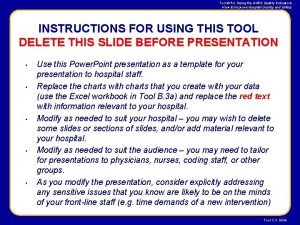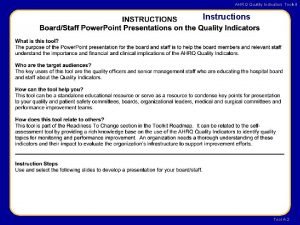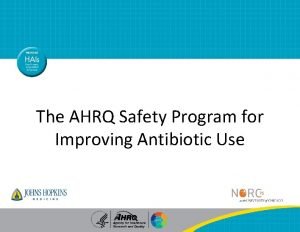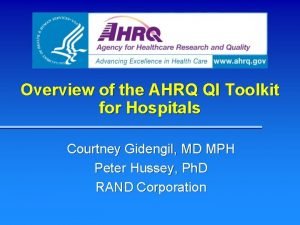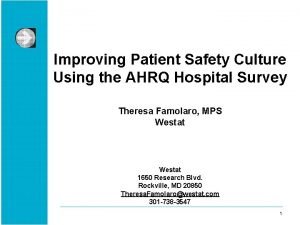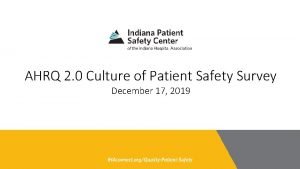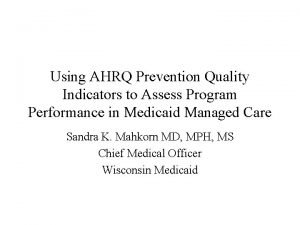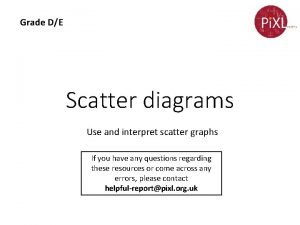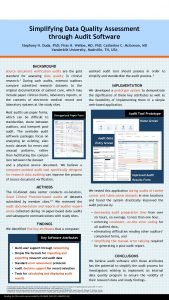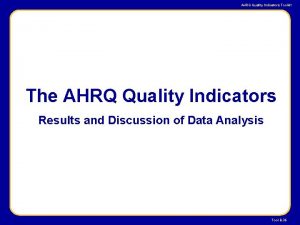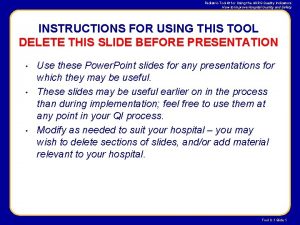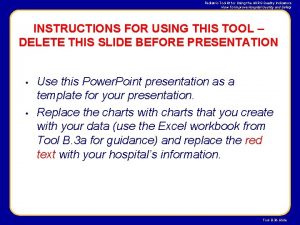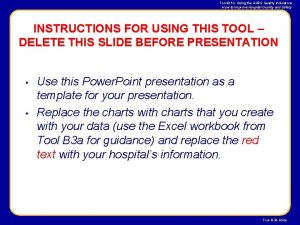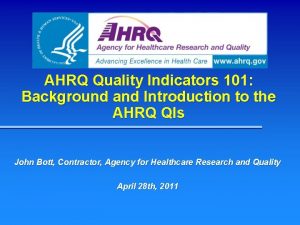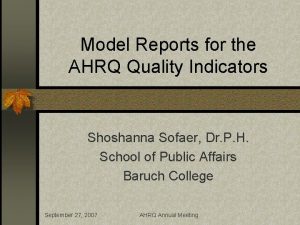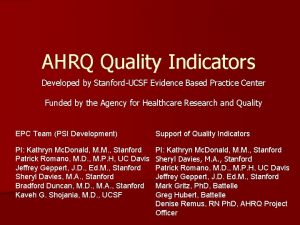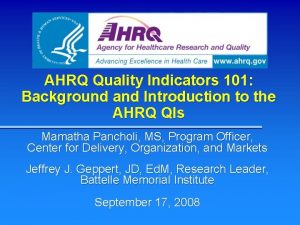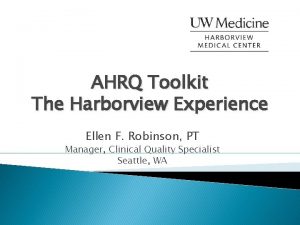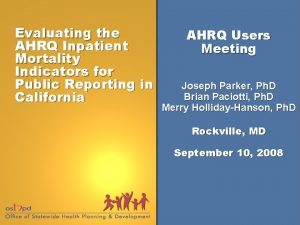AHRQ Quality Indicators Toolkit Instructions Tool A 2





















- Slides: 21

AHRQ Quality Indicators Toolkit Instructions Tool A. 2

AHRQ Quality Indicators Toolkit The Agency for Healthcare Research and Quality Indicators Background for Hospital Boards Date Tool A. 2

AHRQ Quality Indicators Toolkit Why are we here today? The board needs to: • Understand the importance of the AHRQ Quality Indicators (QIs) • Understand the financial and clinical implications of the QIs for our organization • Endorse the QIs as a tool for implementing and monitoring improvement • Make the QIs a priority within our organization Tool A. 2

AHRQ Quality Indicators Toolkit Leadership is key to improvement • Hospital boards are increasingly turning to the QIs as a tool for monitoring performance, particularly on patient safety • To be successful, improvement efforts within hospitals need to have attention and active support from boards and senior hospital leadership • Your active support will demonstrate that the hospital has made it a priority to improve quality and patient safety • This support will help to motivate our staff to engage fully in improvement activities Tool A. 2

AHRQ Quality Indicators Toolkit What is AHRQ? • The Agency for Healthcare Research and Quality: – – Is part of the U. S. Department of Health and Human Services Supports research designed to improve the outcomes and quality of health care, reduce its costs, address patient safety and medical errors, and broaden access to effective services Sponsors, conducts, and disseminates research to help people make more informed decisions and improve the quality of health care services Acts as the regulator for Patient Safety Organizations that are certified under the Patient Safety and Quality Improvement Act Tool A. 2

AHRQ Quality Indicators Toolkit Who developed the QIs? • AHRQ contracted with an Evidence-based Practice Center (EPC) to develop the QIs • The EPC team developed the QIs from 1998 to 2002: – – – Conducted a review of the evidence related to quality measurement based on administrative data Identified candidate indicators using interviews, literature review, Web search and other sources Conducted extensive tests of the validity and reliability of the measures • Pediatric measures were developed later General Questions About the AHRQ QIs. AHRQ Quality Indicators. July 2004. Agency for Healthcare Research and Quality, Rockville, MD. www. qualityindicators. ahrq. gov/FAQs_Support/default. aspx. Tool A. 2

AHRQ Quality Indicators Toolkit What are the Quality Indicators? • The QIs identify quality topics for monitoring and performance improvement: – – Use hospital administrative data Highlight potential quality concerns Identify areas that need further study and investigation Track changes over time • Because we cannot always measure “quality of care” per se, we use certain measures as an “indicator” of quality General Questions About the AHRQ QIs. AHRQ Quality Indicators. July 2004. Agency for Healthcare Research and Quality, Rockville, MD. www. qualityindicators. ahrq. gov/FAQs_Support/default. aspx. Tool A. 2

AHRQ Quality Indicators Toolkit Why were the QIs developed? • Because safety is so important, AHRQ developed QIs to provide health care decisionmakers with user-friendly data and tools that will help them: – – – Assess the effects of health care program and policy choices Guide future health care policymaking Accurately measure outcomes, community access to care, and utilization General Questions About the AHRQ QIs. AHRQ Quality Indicators. July 2004. Agency for Healthcare Research and Quality, Rockville, MD. www. qualityindicators. ahrq. gov/FAQs_Support/default. aspx. Tool A. 2

AHRQ Quality Indicators Toolkit Why are the AHRQ QIs important? • Some QIs will be publicly reported on CMS’s* Hospital Compare • CMS is no longer reimbursing hospitals for some hospital-acquired conditions and safety events measured by the QIs • Fewer resources are available to collect data manually and develop customized quality metrics that may not be accepted by the rest of the field • Sciences of quality and safety are maturing: payers and regulators are taking a lead in dictating project areas * CMS = Centers for Medicare & Medicaid Services. Tool A. 2

AHRQ Quality Indicators Toolkit How are the AHRQ QIs structured? • Definitions based on: – – ICD-9 -CM diagnosis and procedure codes Often along with other measures (e. g. , DRG, MDC, sex, age, procedure dates, admission type) • Numerator = number of cases with the outcome of interest (e. g. , cases with pneumonia) • Denominator = population at risk (e. g. , community population) • Observed rate = numerator/denominator • Some QIs measured as volume counts ICD-9 -CM = International Classification of Diseases, 9 th Revision, Clinical Modification; DRG = diagnosis-related group; MDC = major diagnostic classification. Source: www. qualityindicators. ahrq. gov/resources/Presentations. aspx. Tool A. 2

AHRQ Quality Indicators Toolkit Four Quality Indicator Modules • Patient Safety Indicators (PSIs) reflect quality of care inside hospitals but focus on potentially avoidable complications and iatrogenic events • Inpatient QIs reflect quality of care inside hospitals, including inpatient mortality for medical conditions and surgical procedures • Pediatric QIs reflect quality of care inside hospitals and identify potentially avoidable hospitalizations among children • Prevention QIs identify hospital admissions that evidence suggests could have been avoided, at least in part, through high-quality outpatient care Source: www. qualityindicators. ahrq. gov/Default. aspx. Tool A. 2

AHRQ Quality Indicators Toolkit What are the Patient Safety Indicators? • The PSIs are a set of indicators for adverse events that patients may experience as a result of exposure to the health care system • A composite measure is also available • These events are likely amenable to prevention by changes at the system or provider level • PSIs are measured using hospital administrative data Version 4. 3 technical specifications. Agency for Healthcare Research and Quality, Rockville, MD. www. qualityindicators. ahrq. gov/Modules/PSI_Tech. Spec. aspx. Tool A. 2

AHRQ Quality Indicators Toolkit A PSI Example: Pressure Ulcer (PSI 3) • Numerator: Discharges with ICD-9 -CM code of pressure ulcer stage III or IV in any secondary diagnosis field among cases meeting the inclusion and exclusion rules for the denominator. • Denominator: All medical and surgical discharges age 18 years and older defined by specific DRGs or Medicare Severity DRGs. Source: http: //www. qualityindicators. ahrq. gov/Downloads/Modules/PSI/V 45/Tech. Specs/PSI%2003%20 Pr essure%20 Ulcer%20 Rate. pdf Tool A. 2

AHRQ Quality Indicators Toolkit What are the Inpatient Quality Indicators? • The Inpatient Quality Indicators (IQIs) are a set of 32 indicators of hospital quality of care • The IQIs are measured using hospital administrative data • The IQIs include: – – – Inpatient mortality for certain procedures and medical conditions Utilization of procedures for which there are questions of overuse, underuse, and misuse Volume of procedures for which there is some evidence that a higher volume is associated with lower mortality Inpatient Quality Indicators Overview. AHRQ Quality Indicators. February 2006. Agency for Healthcare Research and Quality, Rockville, MD. www. qualityindicators. ahrq. gov/modules/iqi_overview. aspx. Tool A. 2

AHRQ Quality Indicators Toolkit An IQI Example: Coronary Artery Bypass Graft Mortality Rate (IQI 12) • Numerator: Number of deaths among cases meeting the inclusion and exclusion rules for the denominator. • Denominator: Discharges, age 40 years and older, with ICD-9 -CM CABG code in any procedure field. Source: http: //www. qualityindicators. ahrq. gov/Downloads/Modules/IQI/V 45/Tech. Specs/IQI%2012%20 C oronary%20 Artery%20 Bypass%20 Graft%20%28 CABG%29%20 Mortality%20 Rate. pdf. Tool A. 2

AHRQ Quality Indicators Toolkit How can the AHRQ QIs be used in quality assessment? • QIs can be used to flag potential problems in quality of care • QIs can be used to assess performance and compare against peer hospitals • Examples of hospital use of QIs in the literature have examined the impact of: – – – Health information technology on quality of care Hospital board quality committees on quality of care Evaluation of effectiveness of nurse staffing and care delivered Source: www. qualityindicators. ahrq. gov/Default. aspx and AHRQ Quality Indicator Toolkit Literature Review. Tool A. 2

AHRQ Quality Indicators Toolkit If you already have your current PSI/IQI data available: use slides 1819 If you do not have your PSI/IQI data available: use slides 20 -21. DELETE THIS SLIDE

AHRQ Quality Indicators Toolkit Current performance on the AHRQ QIs • e l p INSERT GRAPHS OR TEXT FROM YOUR HOSPITAL’S DATA HERE m a x E Tool A. 2

AHRQ Quality Indicators Toolkit Next Steps 1. Identify priorities for quality improvement 2. Establish goals and performance targets 3. Formulate an action plan to develop a multidisciplinary team for Quality Indicator work Tool A. 2

AHRQ Quality Indicators Toolkit An Example of a Report on Hospital Performance on the AHRQ QIs Tool A. 2

AHRQ Quality Indicators Toolkit Next Steps 1. Run a QI report with most recent quarter’s data 2. Review QI report at next board meeting 3. Identify priorities for quality improvement 4. Establish goals and performance targets 5. Formulate an action plan to develop multidisciplinary team for QI work Tool A. 2
 Ahrq quality indicators toolkit
Ahrq quality indicators toolkit Ahrq quality indicators
Ahrq quality indicators Ahrq bedside shift report
Ahrq bedside shift report Ahrq antibiotic stewardship
Ahrq antibiotic stewardship Ahrq qi
Ahrq qi Ahrq safety culture survey
Ahrq safety culture survey Ahrq patient safety survey
Ahrq patient safety survey Climate analysis indicators tool
Climate analysis indicators tool Prevention quality indicators
Prevention quality indicators Potter's tool is data cleaning tool
Potter's tool is data cleaning tool Scatter diagram quality tool
Scatter diagram quality tool Data quality audit tool
Data quality audit tool Quality control and quality assurance
Quality control and quality assurance Quality management pmp
Quality management pmp What are quality standards in project management
What are quality standards in project management Quality assurance model in nursing
Quality assurance model in nursing Compliance vs quality
Compliance vs quality Quality control concepts
Quality control concepts American quality gurus
American quality gurus Crosby quality is free
Crosby quality is free What is tqm
What is tqm Dojo
Dojo
